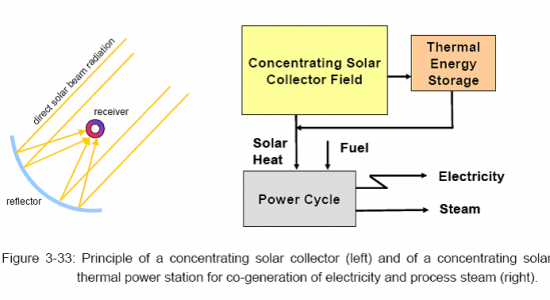Typical regions for concentrating solar are those without lots of atmospheric humidity, dust and fumes. They include steppes, bush, savannas, semi-deserts and true deserts, ideally located within less than 40 degrees of latitude north or south. Therefore, the most promising areas of the world include the South-Western United States, Central and South America, North and Southern Africa, the Mediterranean countries of Europe, the Near and Middle East, Iran and the desert plains of India, Pakistan, the former Soviet Union, China and Australia. (Add the map of sun belt countries)
In these regions, one square kilometre of land is enough to generate as much as 100-130 gigawatt hours (GWh) of solar electricity per year using solar thermal technology. This is the same as the power produced by a 50 MW conventional coal- or gas-fired mid-load power plant. Over the total life cycle of a solar thermal power system, its output would be equivalent to the energy contained in more than 5 million barrels of oil.
Like conventional power plants, CSP plants need cooling at the so-called “cold” end of the steam turbine cycle. This can be achieved through evaporative (wet) cooling where water is available or through dry cooling (with air), both of them conventional technologies. Dry cooling requires higher investment and eventually leads to 5 – 10 % higher cost compared to wet cooling. Hybrid cooling options exist that can optimise performance for the site conditions and are under further development.
However, the huge solar power potential in these areas by far exceeds local demand. So, solar electricity can be exported to regions with a high demand for power with less solar resource. If the sun-belt countries harvest their natural energy in this way, they would be making a big contribution to protecting the global climate. Countries such as Germany are already seriously considering importing solar electricity from North Africa and Southern Europe as to make their power sector more sustainable. Of course, for any new development, local demand should be met first.
Dispatchability
Dispatchability is the ability of a power-producing facility to provide electricity that can be dispatched at required amounts of power on demand of the grid operator. Power plants with dispatchable generation can be turned on or off, or can adjust their power output on demand.
Dispatchability is one of the characteristics that makes CSP a favoured option among other renewable resources, thanks to its storage and the possibility of hybridisation, CSP plants can effectively follow the demand curve with high capacity factors delivering electricity reliably and according to plan.
Thermal Storage system allows provide power during periods of absence of direct solar radiation, so that periods of solar gain and the power supply does not have to happen at the same time. Besides, it allows discharge into the power network requires it, regardless of the direct radiation that is affecting the feedback system.
All CSP plants can store heat energy for short periods of time and thus have a “buffering” capacity that allows them to smooth electricity production considerably and eliminates the short-time variations that non-dispatchable technologies exhibit during cloudy days.
Environment
The main benefit of CSP systems is in replacing the power generated by fossil fuels, and therefore reducing greenhouse gas emissions which cause climate change. Each square metre of CSP concentrator surface, for example, is enough to avoid 200 to 300 kilograms (kg) of carbon dioxide, each year, depending on its configuration. Typical power plants are made up of hundreds of concentrators arranged in arrays. The life-cycle assessment of the components and together with the land surface impacts of CSP systems indicates that it takes around five months to ‘payback’ the energy that is used to manufacture and install the equipment. Considering the plants last at least 30 years and beyond with minimum performance losses, this is a good ratio. Most of the CSP solar field components are common materials and can be recycled and used again for further plants.





